Australian Labor Party: A Worker's Party or a Political Hub?
VerifiedAdded on 2023/06/10
|10
|2808
|436
AI Summary
This article explores whether the Australian Labor Party (ALP) still represents the interests of workers or has transformed into a political hub. It discusses the role of trade unions, the party's constitution, and the changing political landscape.
Contribute Materials
Your contribution can guide someone’s learning journey. Share your
documents today.
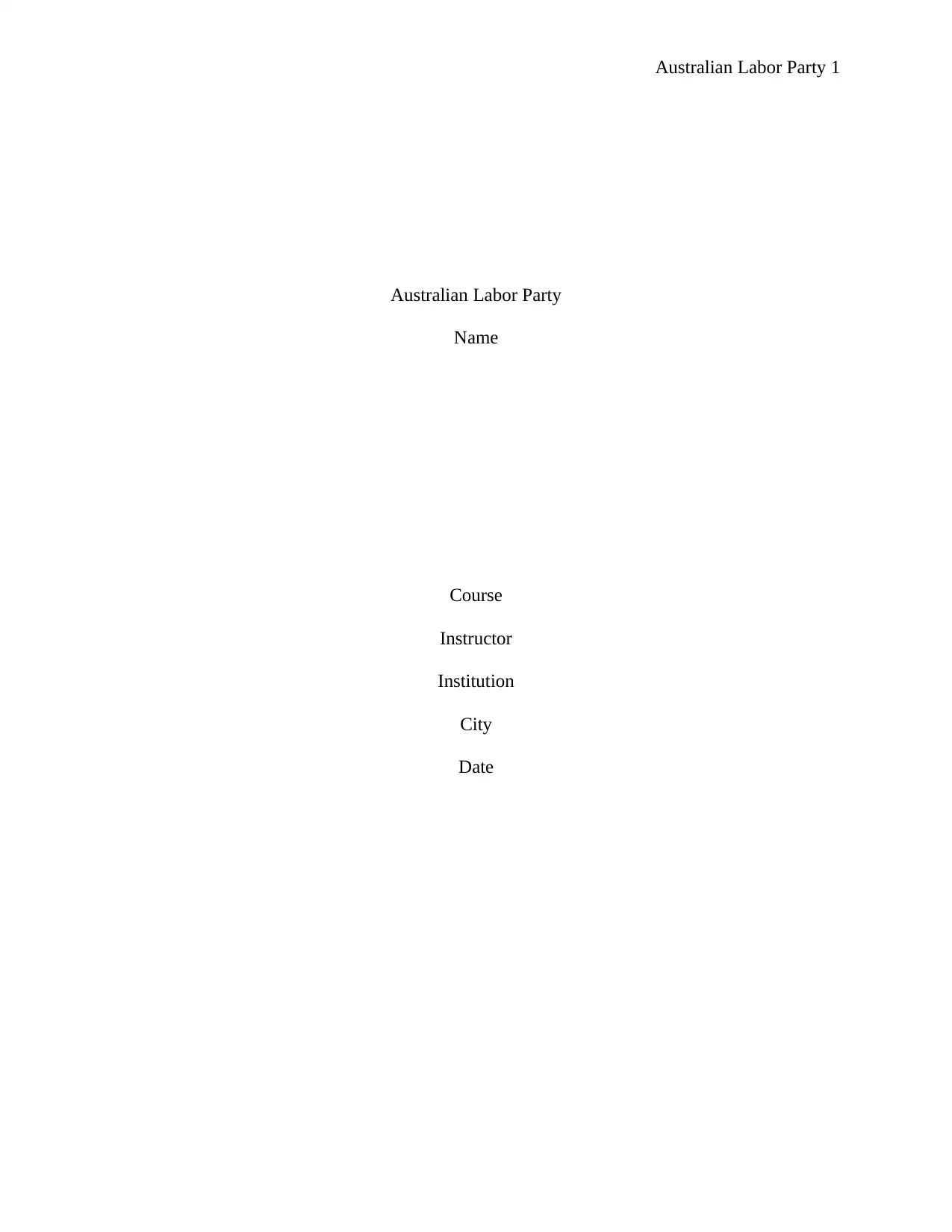
Australian Labor Party 1
Australian Labor Party
Name
Course
Instructor
Institution
City
Date
Australian Labor Party
Name
Course
Instructor
Institution
City
Date
Secure Best Marks with AI Grader
Need help grading? Try our AI Grader for instant feedback on your assignments.
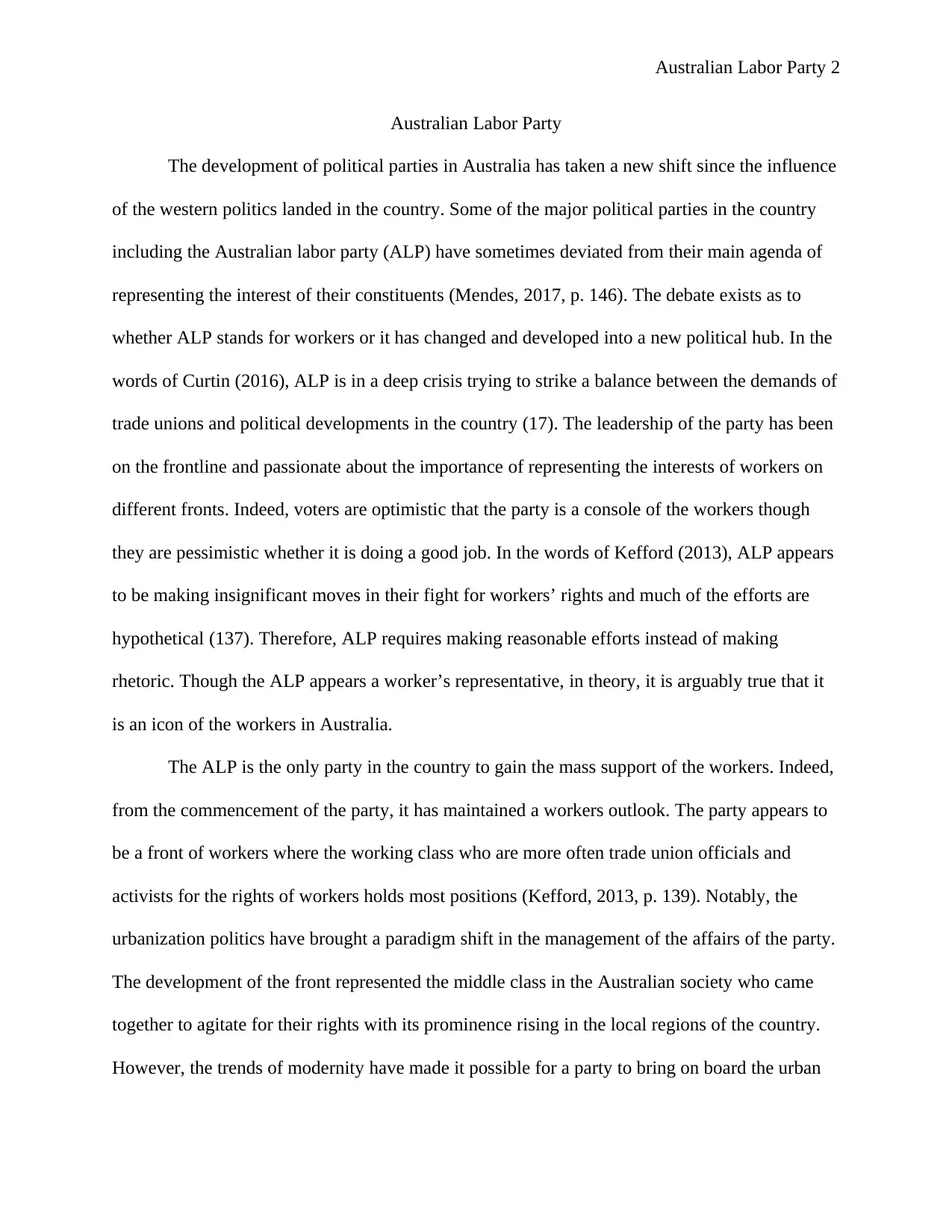
Australian Labor Party 2
Australian Labor Party
The development of political parties in Australia has taken a new shift since the influence
of the western politics landed in the country. Some of the major political parties in the country
including the Australian labor party (ALP) have sometimes deviated from their main agenda of
representing the interest of their constituents (Mendes, 2017, p. 146). The debate exists as to
whether ALP stands for workers or it has changed and developed into a new political hub. In the
words of Curtin (2016), ALP is in a deep crisis trying to strike a balance between the demands of
trade unions and political developments in the country (17). The leadership of the party has been
on the frontline and passionate about the importance of representing the interests of workers on
different fronts. Indeed, voters are optimistic that the party is a console of the workers though
they are pessimistic whether it is doing a good job. In the words of Kefford (2013), ALP appears
to be making insignificant moves in their fight for workers’ rights and much of the efforts are
hypothetical (137). Therefore, ALP requires making reasonable efforts instead of making
rhetoric. Though the ALP appears a worker’s representative, in theory, it is arguably true that it
is an icon of the workers in Australia.
The ALP is the only party in the country to gain the mass support of the workers. Indeed,
from the commencement of the party, it has maintained a workers outlook. The party appears to
be a front of workers where the working class who are more often trade union officials and
activists for the rights of workers holds most positions (Kefford, 2013, p. 139). Notably, the
urbanization politics have brought a paradigm shift in the management of the affairs of the party.
The development of the front represented the middle class in the Australian society who came
together to agitate for their rights with its prominence rising in the local regions of the country.
However, the trends of modernity have made it possible for a party to bring on board the urban
Australian Labor Party
The development of political parties in Australia has taken a new shift since the influence
of the western politics landed in the country. Some of the major political parties in the country
including the Australian labor party (ALP) have sometimes deviated from their main agenda of
representing the interest of their constituents (Mendes, 2017, p. 146). The debate exists as to
whether ALP stands for workers or it has changed and developed into a new political hub. In the
words of Curtin (2016), ALP is in a deep crisis trying to strike a balance between the demands of
trade unions and political developments in the country (17). The leadership of the party has been
on the frontline and passionate about the importance of representing the interests of workers on
different fronts. Indeed, voters are optimistic that the party is a console of the workers though
they are pessimistic whether it is doing a good job. In the words of Kefford (2013), ALP appears
to be making insignificant moves in their fight for workers’ rights and much of the efforts are
hypothetical (137). Therefore, ALP requires making reasonable efforts instead of making
rhetoric. Though the ALP appears a worker’s representative, in theory, it is arguably true that it
is an icon of the workers in Australia.
The ALP is the only party in the country to gain the mass support of the workers. Indeed,
from the commencement of the party, it has maintained a workers outlook. The party appears to
be a front of workers where the working class who are more often trade union officials and
activists for the rights of workers holds most positions (Kefford, 2013, p. 139). Notably, the
urbanization politics have brought a paradigm shift in the management of the affairs of the party.
The development of the front represented the middle class in the Australian society who came
together to agitate for their rights with its prominence rising in the local regions of the country.
However, the trends of modernity have made it possible for a party to bring on board the urban
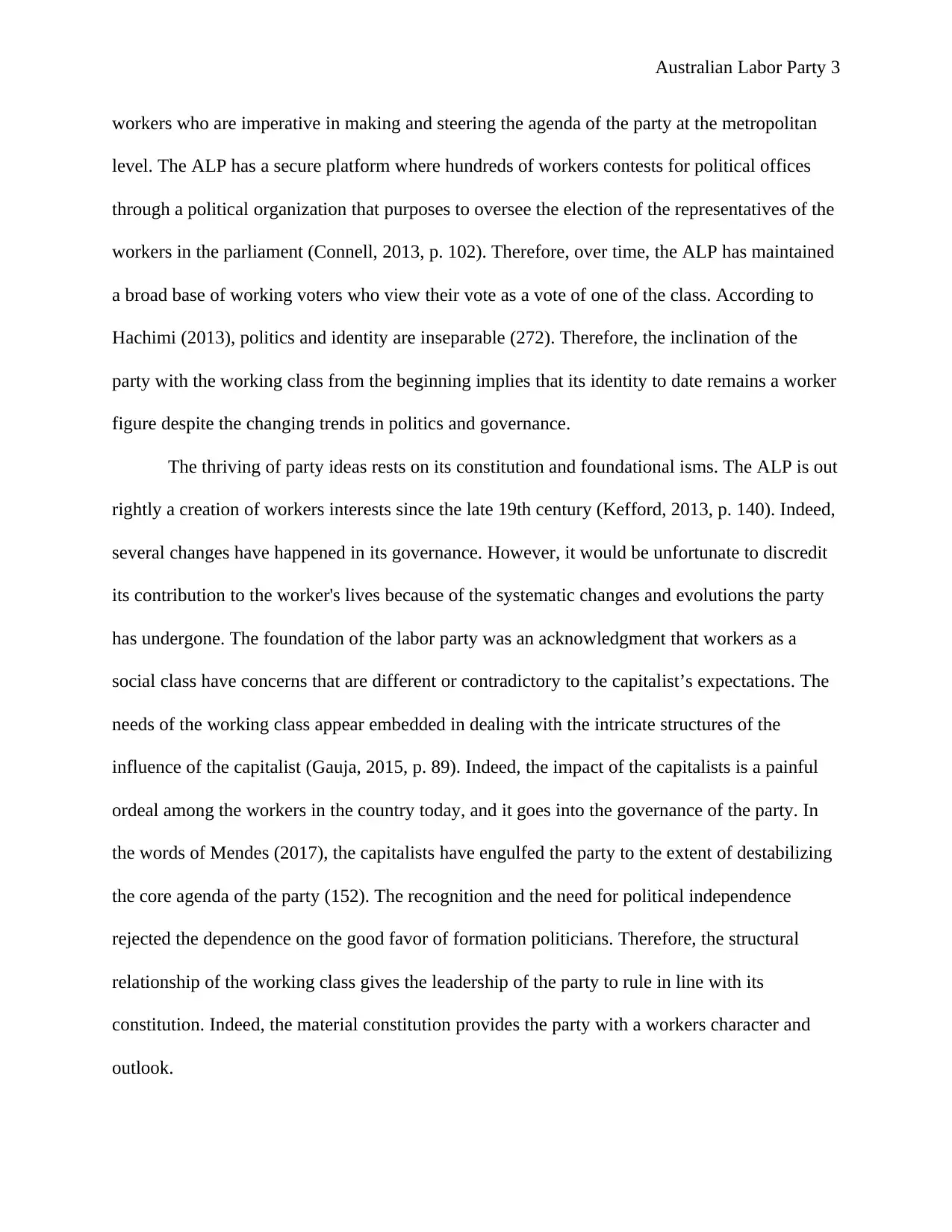
Australian Labor Party 3
workers who are imperative in making and steering the agenda of the party at the metropolitan
level. The ALP has a secure platform where hundreds of workers contests for political offices
through a political organization that purposes to oversee the election of the representatives of the
workers in the parliament (Connell, 2013, p. 102). Therefore, over time, the ALP has maintained
a broad base of working voters who view their vote as a vote of one of the class. According to
Hachimi (2013), politics and identity are inseparable (272). Therefore, the inclination of the
party with the working class from the beginning implies that its identity to date remains a worker
figure despite the changing trends in politics and governance.
The thriving of party ideas rests on its constitution and foundational isms. The ALP is out
rightly a creation of workers interests since the late 19th century (Kefford, 2013, p. 140). Indeed,
several changes have happened in its governance. However, it would be unfortunate to discredit
its contribution to the worker's lives because of the systematic changes and evolutions the party
has undergone. The foundation of the labor party was an acknowledgment that workers as a
social class have concerns that are different or contradictory to the capitalist’s expectations. The
needs of the working class appear embedded in dealing with the intricate structures of the
influence of the capitalist (Gauja, 2015, p. 89). Indeed, the impact of the capitalists is a painful
ordeal among the workers in the country today, and it goes into the governance of the party. In
the words of Mendes (2017), the capitalists have engulfed the party to the extent of destabilizing
the core agenda of the party (152). The recognition and the need for political independence
rejected the dependence on the good favor of formation politicians. Therefore, the structural
relationship of the working class gives the leadership of the party to rule in line with its
constitution. Indeed, the material constitution provides the party with a workers character and
outlook.
workers who are imperative in making and steering the agenda of the party at the metropolitan
level. The ALP has a secure platform where hundreds of workers contests for political offices
through a political organization that purposes to oversee the election of the representatives of the
workers in the parliament (Connell, 2013, p. 102). Therefore, over time, the ALP has maintained
a broad base of working voters who view their vote as a vote of one of the class. According to
Hachimi (2013), politics and identity are inseparable (272). Therefore, the inclination of the
party with the working class from the beginning implies that its identity to date remains a worker
figure despite the changing trends in politics and governance.
The thriving of party ideas rests on its constitution and foundational isms. The ALP is out
rightly a creation of workers interests since the late 19th century (Kefford, 2013, p. 140). Indeed,
several changes have happened in its governance. However, it would be unfortunate to discredit
its contribution to the worker's lives because of the systematic changes and evolutions the party
has undergone. The foundation of the labor party was an acknowledgment that workers as a
social class have concerns that are different or contradictory to the capitalist’s expectations. The
needs of the working class appear embedded in dealing with the intricate structures of the
influence of the capitalist (Gauja, 2015, p. 89). Indeed, the impact of the capitalists is a painful
ordeal among the workers in the country today, and it goes into the governance of the party. In
the words of Mendes (2017), the capitalists have engulfed the party to the extent of destabilizing
the core agenda of the party (152). The recognition and the need for political independence
rejected the dependence on the good favor of formation politicians. Therefore, the structural
relationship of the working class gives the leadership of the party to rule in line with its
constitution. Indeed, the material constitution provides the party with a workers character and
outlook.
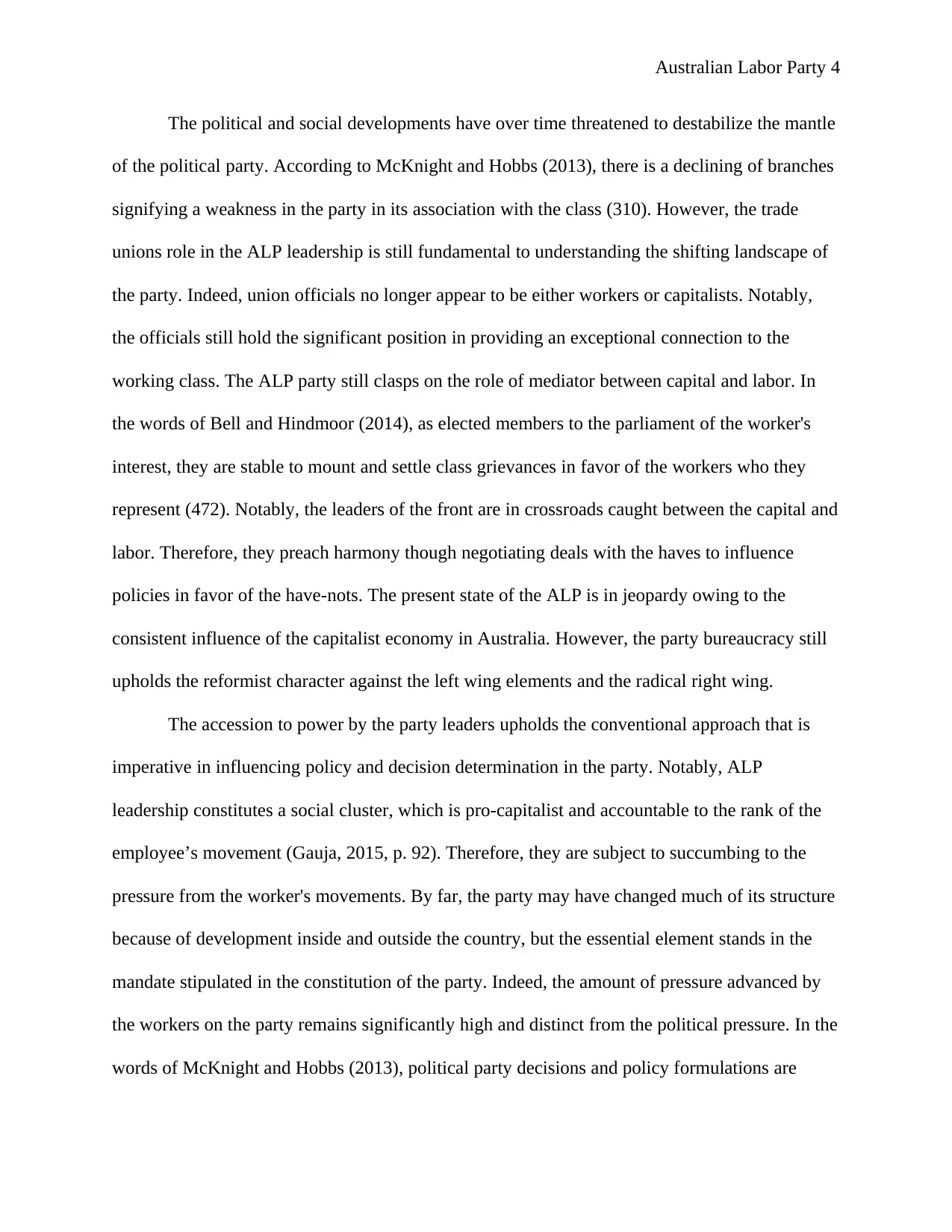
Australian Labor Party 4
The political and social developments have over time threatened to destabilize the mantle
of the political party. According to McKnight and Hobbs (2013), there is a declining of branches
signifying a weakness in the party in its association with the class (310). However, the trade
unions role in the ALP leadership is still fundamental to understanding the shifting landscape of
the party. Indeed, union officials no longer appear to be either workers or capitalists. Notably,
the officials still hold the significant position in providing an exceptional connection to the
working class. The ALP party still clasps on the role of mediator between capital and labor. In
the words of Bell and Hindmoor (2014), as elected members to the parliament of the worker's
interest, they are stable to mount and settle class grievances in favor of the workers who they
represent (472). Notably, the leaders of the front are in crossroads caught between the capital and
labor. Therefore, they preach harmony though negotiating deals with the haves to influence
policies in favor of the have-nots. The present state of the ALP is in jeopardy owing to the
consistent influence of the capitalist economy in Australia. However, the party bureaucracy still
upholds the reformist character against the left wing elements and the radical right wing.
The accession to power by the party leaders upholds the conventional approach that is
imperative in influencing policy and decision determination in the party. Notably, ALP
leadership constitutes a social cluster, which is pro-capitalist and accountable to the rank of the
employee’s movement (Gauja, 2015, p. 92). Therefore, they are subject to succumbing to the
pressure from the worker's movements. By far, the party may have changed much of its structure
because of development inside and outside the country, but the essential element stands in the
mandate stipulated in the constitution of the party. Indeed, the amount of pressure advanced by
the workers on the party remains significantly high and distinct from the political pressure. In the
words of McKnight and Hobbs (2013), political party decisions and policy formulations are
The political and social developments have over time threatened to destabilize the mantle
of the political party. According to McKnight and Hobbs (2013), there is a declining of branches
signifying a weakness in the party in its association with the class (310). However, the trade
unions role in the ALP leadership is still fundamental to understanding the shifting landscape of
the party. Indeed, union officials no longer appear to be either workers or capitalists. Notably,
the officials still hold the significant position in providing an exceptional connection to the
working class. The ALP party still clasps on the role of mediator between capital and labor. In
the words of Bell and Hindmoor (2014), as elected members to the parliament of the worker's
interest, they are stable to mount and settle class grievances in favor of the workers who they
represent (472). Notably, the leaders of the front are in crossroads caught between the capital and
labor. Therefore, they preach harmony though negotiating deals with the haves to influence
policies in favor of the have-nots. The present state of the ALP is in jeopardy owing to the
consistent influence of the capitalist economy in Australia. However, the party bureaucracy still
upholds the reformist character against the left wing elements and the radical right wing.
The accession to power by the party leaders upholds the conventional approach that is
imperative in influencing policy and decision determination in the party. Notably, ALP
leadership constitutes a social cluster, which is pro-capitalist and accountable to the rank of the
employee’s movement (Gauja, 2015, p. 92). Therefore, they are subject to succumbing to the
pressure from the worker's movements. By far, the party may have changed much of its structure
because of development inside and outside the country, but the essential element stands in the
mandate stipulated in the constitution of the party. Indeed, the amount of pressure advanced by
the workers on the party remains significantly high and distinct from the political pressure. In the
words of McKnight and Hobbs (2013), political party decisions and policy formulations are
Secure Best Marks with AI Grader
Need help grading? Try our AI Grader for instant feedback on your assignments.
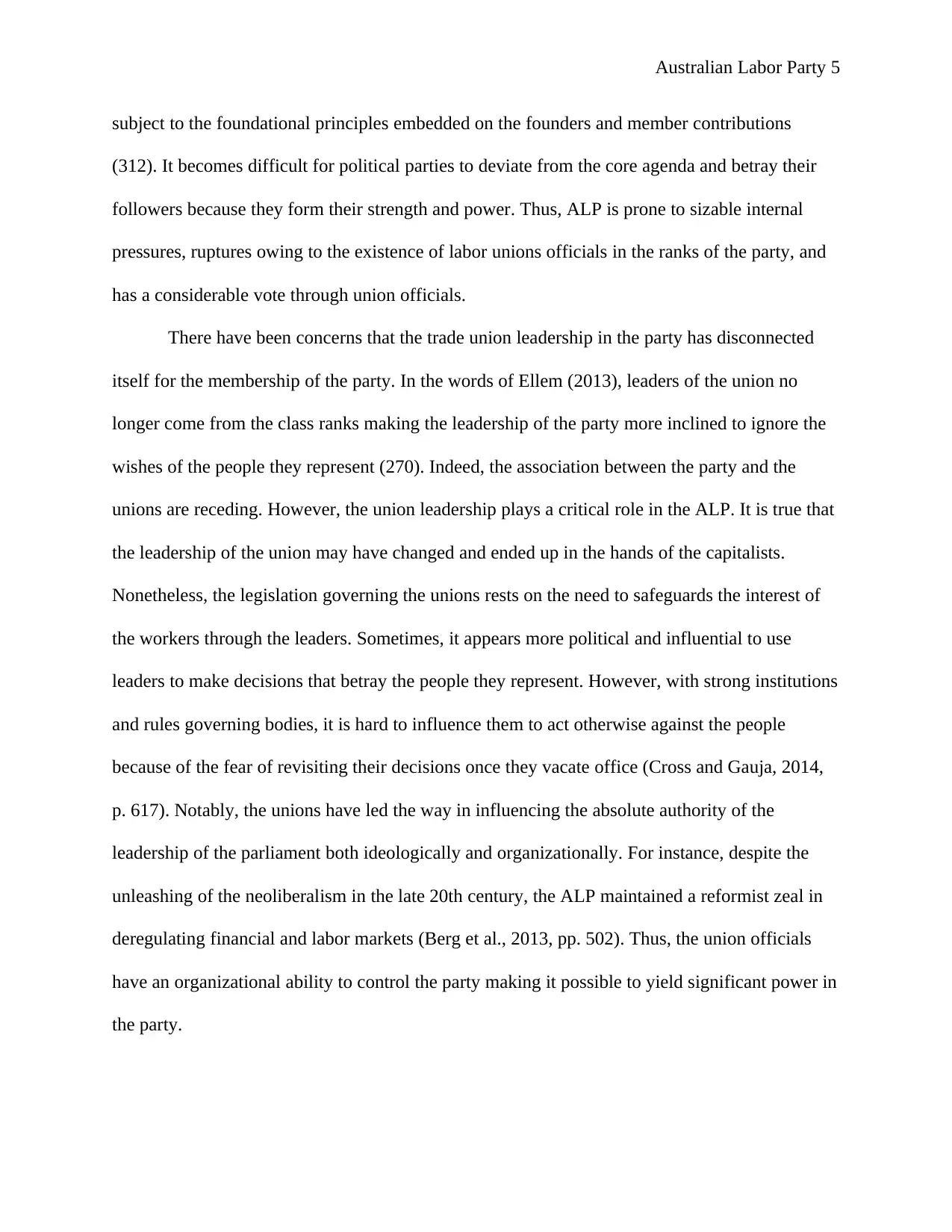
Australian Labor Party 5
subject to the foundational principles embedded on the founders and member contributions
(312). It becomes difficult for political parties to deviate from the core agenda and betray their
followers because they form their strength and power. Thus, ALP is prone to sizable internal
pressures, ruptures owing to the existence of labor unions officials in the ranks of the party, and
has a considerable vote through union officials.
There have been concerns that the trade union leadership in the party has disconnected
itself for the membership of the party. In the words of Ellem (2013), leaders of the union no
longer come from the class ranks making the leadership of the party more inclined to ignore the
wishes of the people they represent (270). Indeed, the association between the party and the
unions are receding. However, the union leadership plays a critical role in the ALP. It is true that
the leadership of the union may have changed and ended up in the hands of the capitalists.
Nonetheless, the legislation governing the unions rests on the need to safeguards the interest of
the workers through the leaders. Sometimes, it appears more political and influential to use
leaders to make decisions that betray the people they represent. However, with strong institutions
and rules governing bodies, it is hard to influence them to act otherwise against the people
because of the fear of revisiting their decisions once they vacate office (Cross and Gauja, 2014,
p. 617). Notably, the unions have led the way in influencing the absolute authority of the
leadership of the parliament both ideologically and organizationally. For instance, despite the
unleashing of the neoliberalism in the late 20th century, the ALP maintained a reformist zeal in
deregulating financial and labor markets (Berg et al., 2013, pp. 502). Thus, the union officials
have an organizational ability to control the party making it possible to yield significant power in
the party.
subject to the foundational principles embedded on the founders and member contributions
(312). It becomes difficult for political parties to deviate from the core agenda and betray their
followers because they form their strength and power. Thus, ALP is prone to sizable internal
pressures, ruptures owing to the existence of labor unions officials in the ranks of the party, and
has a considerable vote through union officials.
There have been concerns that the trade union leadership in the party has disconnected
itself for the membership of the party. In the words of Ellem (2013), leaders of the union no
longer come from the class ranks making the leadership of the party more inclined to ignore the
wishes of the people they represent (270). Indeed, the association between the party and the
unions are receding. However, the union leadership plays a critical role in the ALP. It is true that
the leadership of the union may have changed and ended up in the hands of the capitalists.
Nonetheless, the legislation governing the unions rests on the need to safeguards the interest of
the workers through the leaders. Sometimes, it appears more political and influential to use
leaders to make decisions that betray the people they represent. However, with strong institutions
and rules governing bodies, it is hard to influence them to act otherwise against the people
because of the fear of revisiting their decisions once they vacate office (Cross and Gauja, 2014,
p. 617). Notably, the unions have led the way in influencing the absolute authority of the
leadership of the parliament both ideologically and organizationally. For instance, despite the
unleashing of the neoliberalism in the late 20th century, the ALP maintained a reformist zeal in
deregulating financial and labor markets (Berg et al., 2013, pp. 502). Thus, the union officials
have an organizational ability to control the party making it possible to yield significant power in
the party.
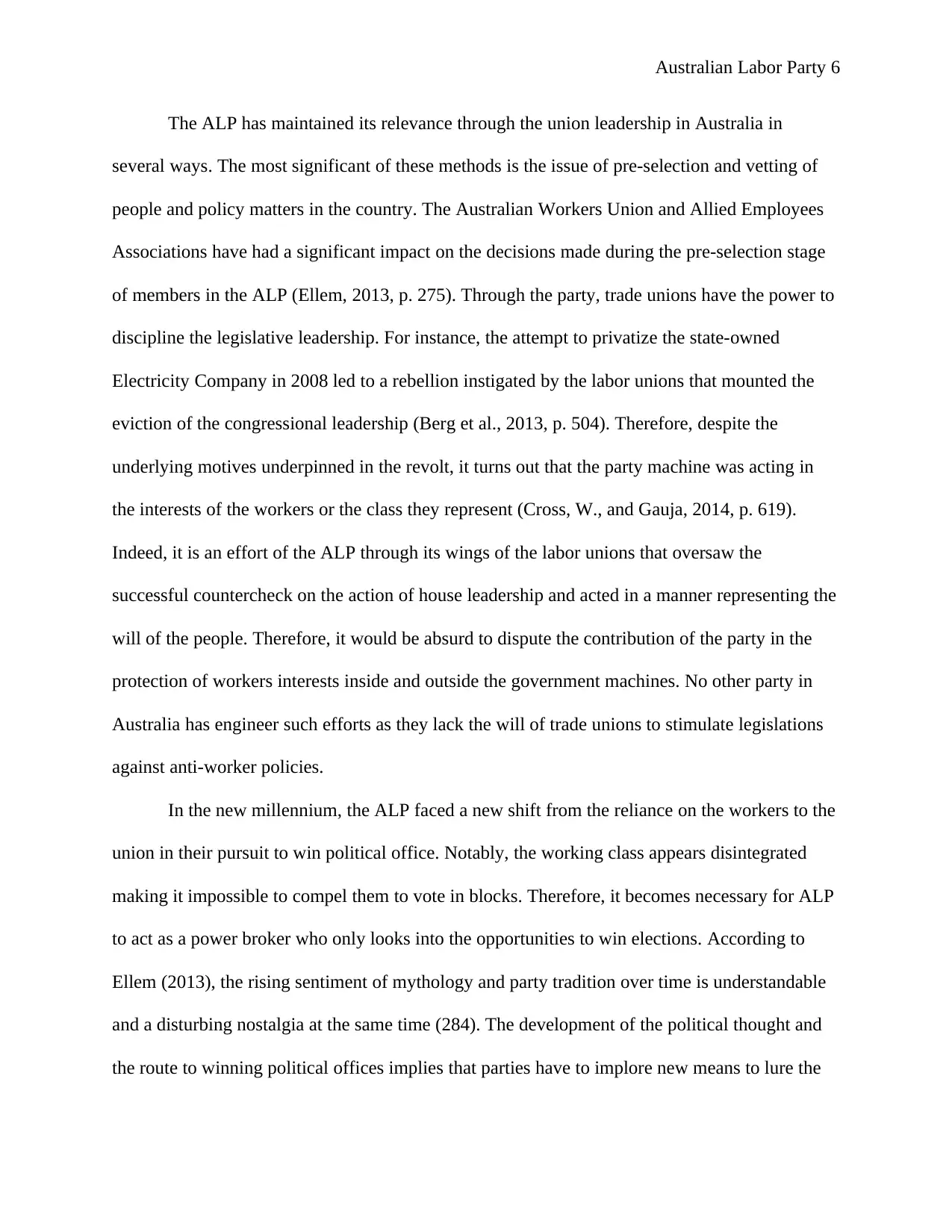
Australian Labor Party 6
The ALP has maintained its relevance through the union leadership in Australia in
several ways. The most significant of these methods is the issue of pre-selection and vetting of
people and policy matters in the country. The Australian Workers Union and Allied Employees
Associations have had a significant impact on the decisions made during the pre-selection stage
of members in the ALP (Ellem, 2013, p. 275). Through the party, trade unions have the power to
discipline the legislative leadership. For instance, the attempt to privatize the state-owned
Electricity Company in 2008 led to a rebellion instigated by the labor unions that mounted the
eviction of the congressional leadership (Berg et al., 2013, p. 504). Therefore, despite the
underlying motives underpinned in the revolt, it turns out that the party machine was acting in
the interests of the workers or the class they represent (Cross, W., and Gauja, 2014, p. 619).
Indeed, it is an effort of the ALP through its wings of the labor unions that oversaw the
successful countercheck on the action of house leadership and acted in a manner representing the
will of the people. Therefore, it would be absurd to dispute the contribution of the party in the
protection of workers interests inside and outside the government machines. No other party in
Australia has engineer such efforts as they lack the will of trade unions to stimulate legislations
against anti-worker policies.
In the new millennium, the ALP faced a new shift from the reliance on the workers to the
union in their pursuit to win political office. Notably, the working class appears disintegrated
making it impossible to compel them to vote in blocks. Therefore, it becomes necessary for ALP
to act as a power broker who only looks into the opportunities to win elections. According to
Ellem (2013), the rising sentiment of mythology and party tradition over time is understandable
and a disturbing nostalgia at the same time (284). The development of the political thought and
the route to winning political offices implies that parties have to implore new means to lure the
The ALP has maintained its relevance through the union leadership in Australia in
several ways. The most significant of these methods is the issue of pre-selection and vetting of
people and policy matters in the country. The Australian Workers Union and Allied Employees
Associations have had a significant impact on the decisions made during the pre-selection stage
of members in the ALP (Ellem, 2013, p. 275). Through the party, trade unions have the power to
discipline the legislative leadership. For instance, the attempt to privatize the state-owned
Electricity Company in 2008 led to a rebellion instigated by the labor unions that mounted the
eviction of the congressional leadership (Berg et al., 2013, p. 504). Therefore, despite the
underlying motives underpinned in the revolt, it turns out that the party machine was acting in
the interests of the workers or the class they represent (Cross, W., and Gauja, 2014, p. 619).
Indeed, it is an effort of the ALP through its wings of the labor unions that oversaw the
successful countercheck on the action of house leadership and acted in a manner representing the
will of the people. Therefore, it would be absurd to dispute the contribution of the party in the
protection of workers interests inside and outside the government machines. No other party in
Australia has engineer such efforts as they lack the will of trade unions to stimulate legislations
against anti-worker policies.
In the new millennium, the ALP faced a new shift from the reliance on the workers to the
union in their pursuit to win political office. Notably, the working class appears disintegrated
making it impossible to compel them to vote in blocks. Therefore, it becomes necessary for ALP
to act as a power broker who only looks into the opportunities to win elections. According to
Ellem (2013), the rising sentiment of mythology and party tradition over time is understandable
and a disturbing nostalgia at the same time (284). The development of the political thought and
the route to winning political offices implies that parties have to implore new means to lure the
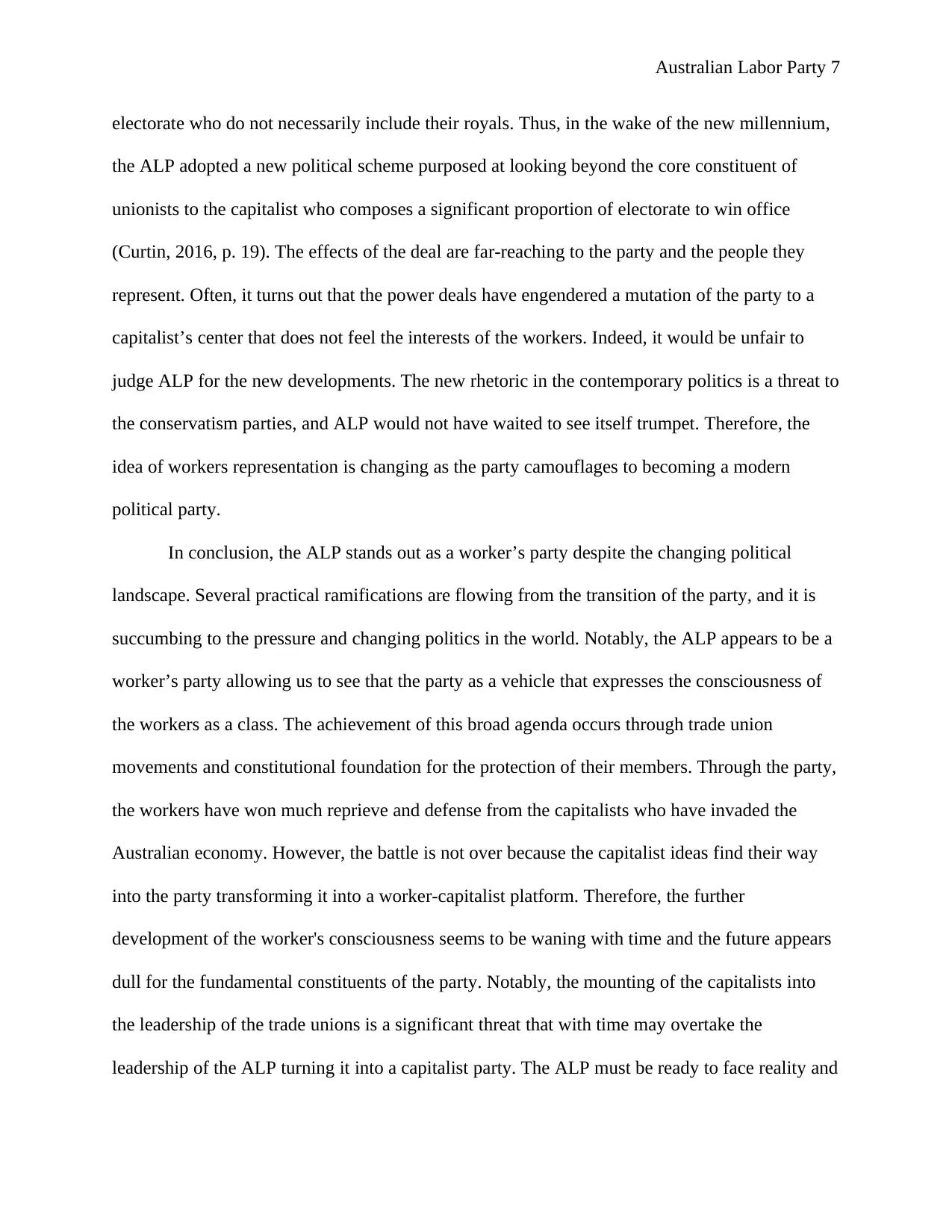
Australian Labor Party 7
electorate who do not necessarily include their royals. Thus, in the wake of the new millennium,
the ALP adopted a new political scheme purposed at looking beyond the core constituent of
unionists to the capitalist who composes a significant proportion of electorate to win office
(Curtin, 2016, p. 19). The effects of the deal are far-reaching to the party and the people they
represent. Often, it turns out that the power deals have engendered a mutation of the party to a
capitalist’s center that does not feel the interests of the workers. Indeed, it would be unfair to
judge ALP for the new developments. The new rhetoric in the contemporary politics is a threat to
the conservatism parties, and ALP would not have waited to see itself trumpet. Therefore, the
idea of workers representation is changing as the party camouflages to becoming a modern
political party.
In conclusion, the ALP stands out as a worker’s party despite the changing political
landscape. Several practical ramifications are flowing from the transition of the party, and it is
succumbing to the pressure and changing politics in the world. Notably, the ALP appears to be a
worker’s party allowing us to see that the party as a vehicle that expresses the consciousness of
the workers as a class. The achievement of this broad agenda occurs through trade union
movements and constitutional foundation for the protection of their members. Through the party,
the workers have won much reprieve and defense from the capitalists who have invaded the
Australian economy. However, the battle is not over because the capitalist ideas find their way
into the party transforming it into a worker-capitalist platform. Therefore, the further
development of the worker's consciousness seems to be waning with time and the future appears
dull for the fundamental constituents of the party. Notably, the mounting of the capitalists into
the leadership of the trade unions is a significant threat that with time may overtake the
leadership of the ALP turning it into a capitalist party. The ALP must be ready to face reality and
electorate who do not necessarily include their royals. Thus, in the wake of the new millennium,
the ALP adopted a new political scheme purposed at looking beyond the core constituent of
unionists to the capitalist who composes a significant proportion of electorate to win office
(Curtin, 2016, p. 19). The effects of the deal are far-reaching to the party and the people they
represent. Often, it turns out that the power deals have engendered a mutation of the party to a
capitalist’s center that does not feel the interests of the workers. Indeed, it would be unfair to
judge ALP for the new developments. The new rhetoric in the contemporary politics is a threat to
the conservatism parties, and ALP would not have waited to see itself trumpet. Therefore, the
idea of workers representation is changing as the party camouflages to becoming a modern
political party.
In conclusion, the ALP stands out as a worker’s party despite the changing political
landscape. Several practical ramifications are flowing from the transition of the party, and it is
succumbing to the pressure and changing politics in the world. Notably, the ALP appears to be a
worker’s party allowing us to see that the party as a vehicle that expresses the consciousness of
the workers as a class. The achievement of this broad agenda occurs through trade union
movements and constitutional foundation for the protection of their members. Through the party,
the workers have won much reprieve and defense from the capitalists who have invaded the
Australian economy. However, the battle is not over because the capitalist ideas find their way
into the party transforming it into a worker-capitalist platform. Therefore, the further
development of the worker's consciousness seems to be waning with time and the future appears
dull for the fundamental constituents of the party. Notably, the mounting of the capitalists into
the leadership of the trade unions is a significant threat that with time may overtake the
leadership of the ALP turning it into a capitalist party. The ALP must be ready to face reality and
Paraphrase This Document
Need a fresh take? Get an instant paraphrase of this document with our AI Paraphraser
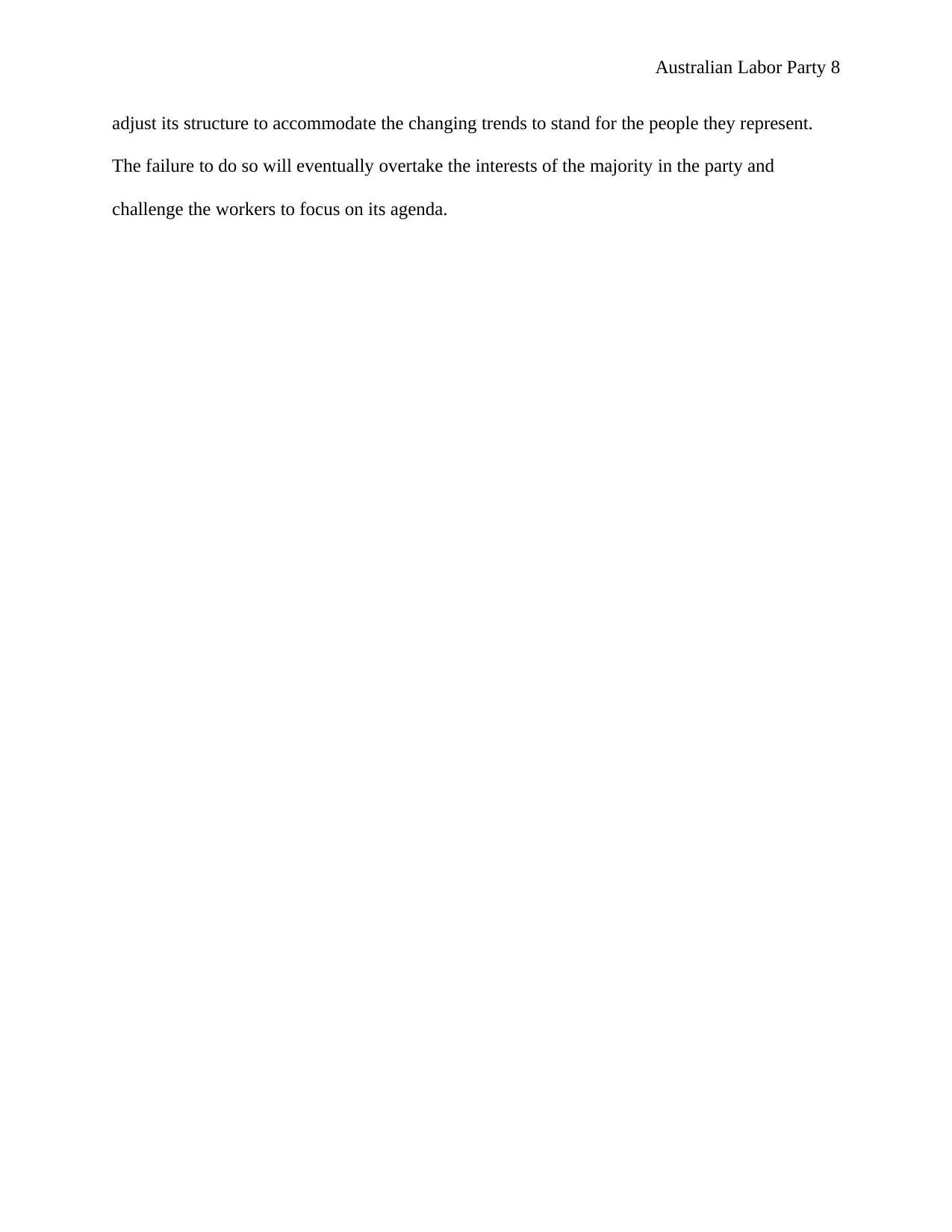
Australian Labor Party 8
adjust its structure to accommodate the changing trends to stand for the people they represent.
The failure to do so will eventually overtake the interests of the majority in the party and
challenge the workers to focus on its agenda.
adjust its structure to accommodate the changing trends to stand for the people they represent.
The failure to do so will eventually overtake the interests of the majority in the party and
challenge the workers to focus on its agenda.
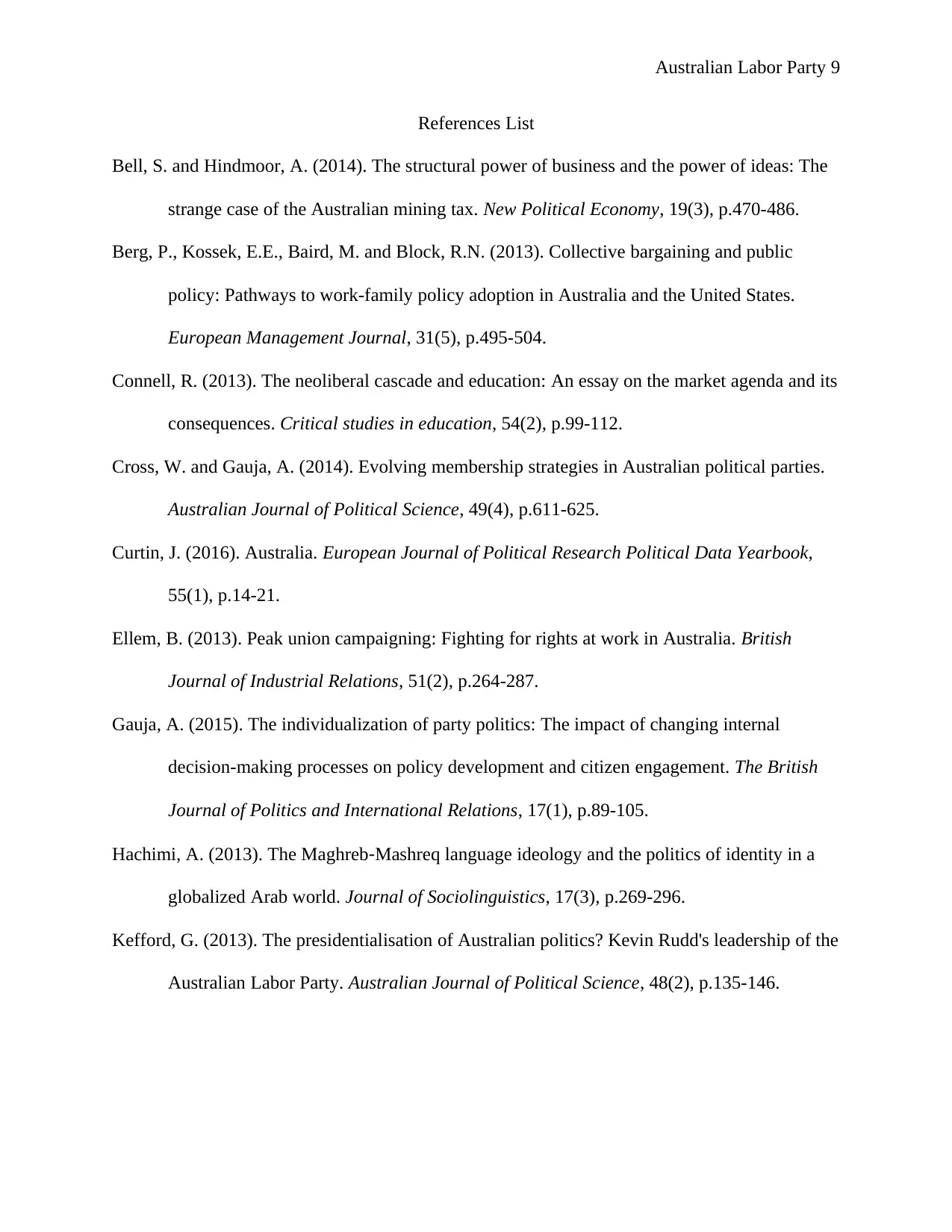
Australian Labor Party 9
References List
Bell, S. and Hindmoor, A. (2014). The structural power of business and the power of ideas: The
strange case of the Australian mining tax. New Political Economy, 19(3), p.470-486.
Berg, P., Kossek, E.E., Baird, M. and Block, R.N. (2013). Collective bargaining and public
policy: Pathways to work-family policy adoption in Australia and the United States.
European Management Journal, 31(5), p.495-504.
Connell, R. (2013). The neoliberal cascade and education: An essay on the market agenda and its
consequences. Critical studies in education, 54(2), p.99-112.
Cross, W. and Gauja, A. (2014). Evolving membership strategies in Australian political parties.
Australian Journal of Political Science, 49(4), p.611-625.
Curtin, J. (2016). Australia. European Journal of Political Research Political Data Yearbook,
55(1), p.14-21.
Ellem, B. (2013). Peak union campaigning: Fighting for rights at work in Australia. British
Journal of Industrial Relations, 51(2), p.264-287.
Gauja, A. (2015). The individualization of party politics: The impact of changing internal
decision-making processes on policy development and citizen engagement. The British
Journal of Politics and International Relations, 17(1), p.89-105.
Hachimi, A. (2013). The Maghreb‐Mashreq language ideology and the politics of identity in a
globalized Arab world. Journal of Sociolinguistics, 17(3), p.269-296.
Kefford, G. (2013). The presidentialisation of Australian politics? Kevin Rudd's leadership of the
Australian Labor Party. Australian Journal of Political Science, 48(2), p.135-146.
References List
Bell, S. and Hindmoor, A. (2014). The structural power of business and the power of ideas: The
strange case of the Australian mining tax. New Political Economy, 19(3), p.470-486.
Berg, P., Kossek, E.E., Baird, M. and Block, R.N. (2013). Collective bargaining and public
policy: Pathways to work-family policy adoption in Australia and the United States.
European Management Journal, 31(5), p.495-504.
Connell, R. (2013). The neoliberal cascade and education: An essay on the market agenda and its
consequences. Critical studies in education, 54(2), p.99-112.
Cross, W. and Gauja, A. (2014). Evolving membership strategies in Australian political parties.
Australian Journal of Political Science, 49(4), p.611-625.
Curtin, J. (2016). Australia. European Journal of Political Research Political Data Yearbook,
55(1), p.14-21.
Ellem, B. (2013). Peak union campaigning: Fighting for rights at work in Australia. British
Journal of Industrial Relations, 51(2), p.264-287.
Gauja, A. (2015). The individualization of party politics: The impact of changing internal
decision-making processes on policy development and citizen engagement. The British
Journal of Politics and International Relations, 17(1), p.89-105.
Hachimi, A. (2013). The Maghreb‐Mashreq language ideology and the politics of identity in a
globalized Arab world. Journal of Sociolinguistics, 17(3), p.269-296.
Kefford, G. (2013). The presidentialisation of Australian politics? Kevin Rudd's leadership of the
Australian Labor Party. Australian Journal of Political Science, 48(2), p.135-146.
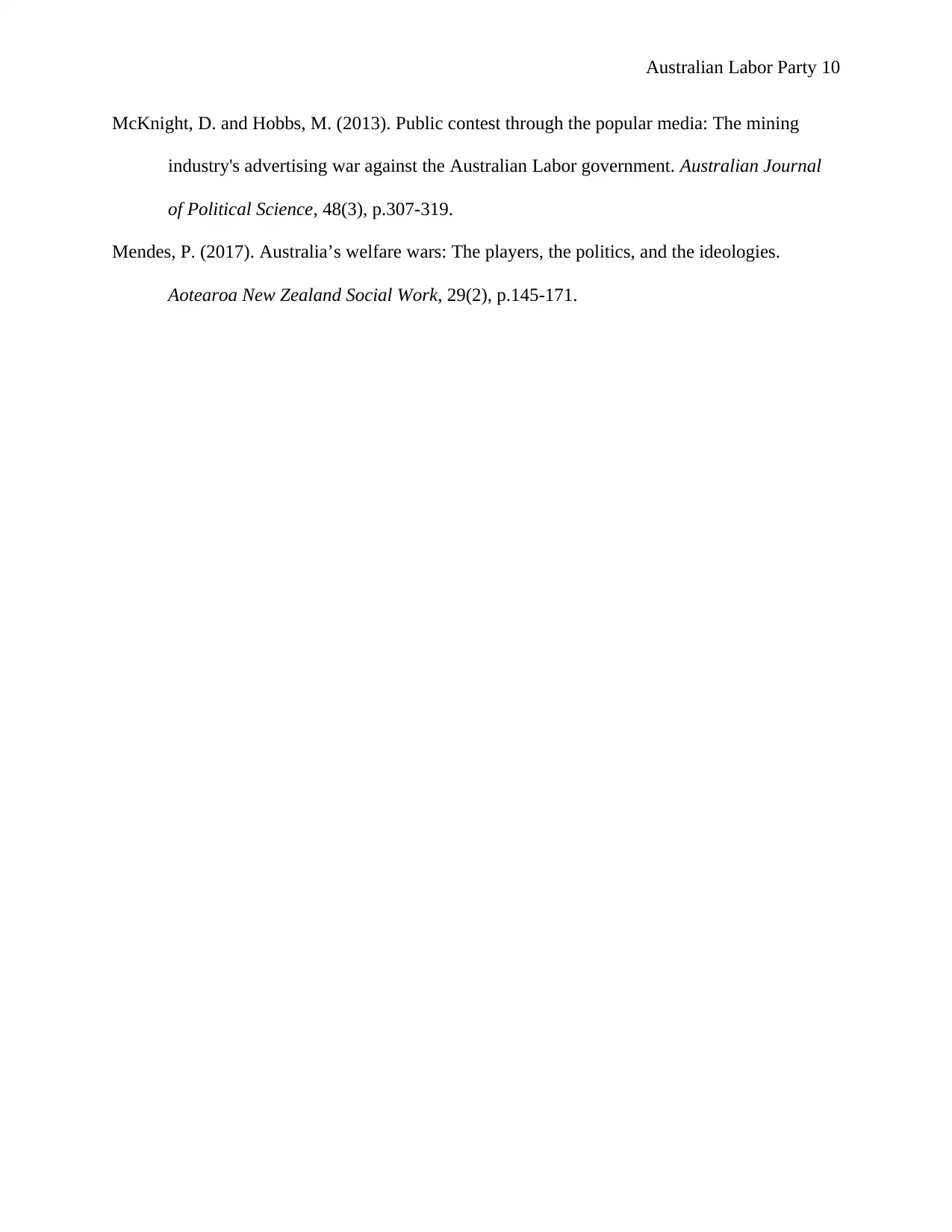
Australian Labor Party 10
McKnight, D. and Hobbs, M. (2013). Public contest through the popular media: The mining
industry's advertising war against the Australian Labor government. Australian Journal
of Political Science, 48(3), p.307-319.
Mendes, P. (2017). Australia’s welfare wars: The players, the politics, and the ideologies.
Aotearoa New Zealand Social Work, 29(2), p.145-171.
McKnight, D. and Hobbs, M. (2013). Public contest through the popular media: The mining
industry's advertising war against the Australian Labor government. Australian Journal
of Political Science, 48(3), p.307-319.
Mendes, P. (2017). Australia’s welfare wars: The players, the politics, and the ideologies.
Aotearoa New Zealand Social Work, 29(2), p.145-171.
1 out of 10
Your All-in-One AI-Powered Toolkit for Academic Success.
+13062052269
info@desklib.com
Available 24*7 on WhatsApp / Email
![[object Object]](/_next/static/media/star-bottom.7253800d.svg)
Unlock your academic potential
© 2024 | Zucol Services PVT LTD | All rights reserved.